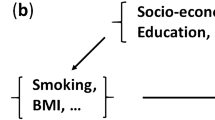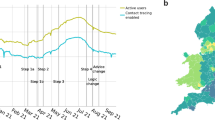Abstract
Most studies of mobile phone use are case–control studies that rely on participants’ reports of past phone use for their exposure assessment. Differential errors in recalled phone use are a major concern in such studies. INTERPHONE, a multinational case–control study of brain tumour risk and mobile phone use, included validation studies to quantify such errors and evaluate the potential for recall bias. Mobile phone records of 212 cases and 296 controls were collected from network operators in three INTERPHONE countries over an average of 2 years, and compared with mobile phone use reported at interview. The ratio of reported to recorded phone use was analysed as measure of agreement. Mean ratios were virtually the same for cases and controls: both underestimated number of calls by a factor of 0.81 and overestimated call duration by a factor of 1.4. For cases, but not controls, ratios increased with increasing time before the interview; however, these trends were based on few subjects with long-term data. Ratios increased by level of use. Random recall errors were large. In conclusion, there was little evidence for differential recall errors overall or in recent time periods. However, apparent overestimation by cases in more distant time periods could cause positive bias in estimates of disease risk associated with mobile phone use.
This is a preview of subscription content, access via your institution
Access options
Subscribe to this journal
Receive 6 print issues and online access
$259.00 per year
only $43.17 per issue
Buy this article
- Purchase on Springer Link
- Instant access to full article PDF
Prices may be subject to local taxes which are calculated during checkout


Similar content being viewed by others
References
Armstrong B.G. The effects of measurement errors on relative risk regressions. Am J Epidemiol 1990: 132: 1176–1184.
Armstrong B.K., White E., and Saracci R. Principles of Exposure Measurement in Epidemiology. Oxford University Press, Oxford, 1992.
Auvinen A., Hietanen M., Luukkonen R., and Koskela R.S. Brain tumors and salivary gland cancers among cellular telephone users. Epidemiology 2002: 13: 356–359.
Auvinen A., Toivo T., and Tokola K. Epidemiological risk assessment of mobile phones and cancer: where can we improve? Eur J Cancer Prev 2006: 15: 516–523.
Berg G., Schuz J., Samkange-Zeeb F., and Blettner M. Assessment of radiofrequency exposure from cellular telephone daily use in an epidemiological study: German validation study of the international case–control study of cancers of the brain — INTERPHONE-Study. J Expo Anal Environ Epidemiol 2005: 15: 217–224.
Bland J.M., and Altman D.G. Comparing methods of measurement: why plotting difference against standard method is misleading. Lancet 1995: 346: 1085–1087.
Bland J.M., and Altman D.G. Measuring agreement in method comparison studies. Stat Methods Med Res 1999: 8: 135–160.
Cardis E., and Kilkenny M. International case–control study of adult brain, head and neck tumours: results of the feasibility study. Rad Prot Dos 1999: 83: 179–183.
Cardis E., Richardson L., Deltour I., Armstrong B., Feychting M., and Johansen C., et al. The INTERPHONE Study: design, epidemiological methods, and description of the study population. Eur J Epidemiol 2007: 22: 647–664.
Christensen H.C., Schuz J., Kosteljanetz M., Poulsen H.S., Boice Jr J.D., and McLaughlin J.K., et al. Cellular telephones and risk for brain tumors: a population-based, incident case–control study. Neurology 2005: 64: 1189–1195.
Christensen H.C., Schuz J., Kosteljanetz M., Poulsen H.S., Thomsen J., and Johansen C. Cellular telephone use and risk of acoustic neuroma. Am J Epidemiol 2004: 159: 277–283.
Drews C.D., and Greenland S. The impact of differential recall on the results of case–control studies. Int J Epidemiol 1990: 19: 1107–1112.
Hardell L., Carlberg M., and Hansson M.K. Case–control study on cellular and cordless telephones and the risk for acoustic neuroma or meningioma in patients diagnosed 2000–2003. Neuroepidemiology 2005: 25: 120–128.
Hepworth S.J., Schoemaker M.J., Muir K.R., Swerdlow A.J., van Tongeren M.J., and McKinney P.A. Mobile phone use and risk of glioma in adults: case-control study. Br Med J 2006: 332: 883–887.
Hours M., Bernard M., Montestrucq L., Arslan M., Bergeret A., and Deltour I., et al. [Cell phones and risk of brain and acoustic nerve tumours: the French INTERPHONE case–control study]. Rev Epidemiol Santé Publique 2007a: 55: 321–332.
Hours M., Montestrucq L., Arslan M., Bernard M., El Hadjimoussa H., and Vrijheid M., et al. [Validation des outils utilisés pour la mesure de la consommation téléphonique mobile dans l’étude INTERPHONE en France]. Evironnement, Risques & Santé 2007b: 6: 101–109.
Infante-Rivard C., and Jacques L. Empirical study of parential recall bias. Am J Epidemiol 2000: 152: 480–486.
Inskip P.D., Tarone R.E., Hatch E.E., Wilcosky T.C., Shapiro W.R., and Selker R.G., et al. Cellular-telephone use and brain tumors. N Engl J Med 2001: 344: 79–86.
Inyang I., Benke G., McKenzie R., and Abramson M. Comparison of measuring instruments for radiofrequency radiation from mobile telephones in epidemiological studies: implications for exposure assessment. J Exp Sci Environ Epidemiol 2008: 18 (2): 134–141.
Johansen C., Boice Jr J., McLaughlin J., and Olsen J. Cellular telephones and cancer — a nationwide cohort study in Denmark. J Natl Cancer Inst 2001: 93: 203–207.
Klaeboe L., Blaasaas K.G., and Tynes T. Use of mobile phones in Norway and risk of intracranial tumours. Eur J Cancer Prev 2007: 16: 158–164.
Lahkola A., Auvinen A., Raitanen J., Schoemaker M.J., Christensen H.C., and Feychting M., et al. Mobile phone use and risk of glioma in 5 North European countries. Int J Cancer 2007: 120: 1769–1775.
Landis J.R., and Koch G.G. The measurement of observer agreement for categorical data. Biometrics 1977: 33: 159–174.
Lonn S., Ahlbom A., Christensen H.C., Johansen C., Schuz J., and Edstrom S., et al. Mobile phone use and risk of parotid gland tumor. Am J Epidemiol 2006: 164: 637–643.
Lonn S., Ahlbom A., Hall P., and Feychting M. Mobile phone use and the risk of acoustic neuroma. Epidemiology 2004: 15: 653–659.
Lonn S., Ahlbom A., Hall P., and Feychting M. Long-term mobile phone use and brain tumor risk. Am J Epidemiol 2005: 161: 526–535.
Morrissey J.J. Radio frequency exposure in mobile phone users: implications for exposure assessment in epidemiologic studies. Radiat Prot Dosimetry 2007: 123: 490–497.
Muscat J.E., Malkin M.G., Shore R.E., Thompson S., Neugut A.I., and Stellman S.D., et al. Handheld cellular telephones and risk of acoustic neuroma. Neurology 2002: 58: 1304–1306.
Muscat J.E., Malkin M.G., Thompson S., Shore R.E., Stellman S.D., and McRee D., et al. Handheld cellular telephone use and risk of brain cancer. JAMA 2000: 284: 3001–3007.
Parslow R.C., Hepworth S.J., and McKinney P.A. Recall of past use of mobile phone handsets. Radiat Prot Dosimetry 2003: 106: 233–240.
Salander P., Karlsson T., Bergenheim T., and Henriksson R. Long-term memory deficits inpatients with malignant gliomas. J Neurooncol 1995: 25: 227–238.
Samkange-Zeeb F., Berg G., and Blettner M. Validation of self-reported cellular phone use. J Expo Anal Environ Epidemiol 2004: 14: 245–248.
Schlehofer B., Schlaefer K., Blettner M., Berg G., Bohler E., and Hettinger I., et al. Environmental risk factors for sporadic acoustic neuroma (Interphone Study Group, Germany). Eur J Cancer 2007: 43: 1741–1747.
Schoemaker M.J., Swerdlow A.J., Ahlbom A., Auvinen A., Blaasaas K.G., and Cardis E., et al. Mobile phone use and risk of acoustic neuroma: results of the Interphone case–control study in five North European countries. Br J Cancer 2005: 93: 842–848.
Schuz J., Bohler E., Berg G., Schlehofer B., Hettinger I., and Schlaefer K., et al. Cellular phones, cordless phones, and the risks of glioma and meningioma (Interphone Study Group, Germany). Am J Epidemiol 2006a: 163: 512–520.
Schuz J., Jacobsen R., Olsen J.H., Boice Jr J.D., McLaughlin J.K., and Johansen C. Cellular telephone use and cancer risk: update of a nationwide Danish cohort. J Natl Cancer Inst 2006b: 98: 1707–1713.
StataCorp. STATA Statistical Software: Release 9.0. Stata Press, College Station, Texas, 2005.
Takebayashi T., Akiba S., Kikuchi Y., Taki M., Wake K., and Watanabe S., et al. Mobile phone use and acoustic neuroma risk in Japan. Occup Environ Med 2006: 63: 802–807.
Tucha O., Smely C., Preier M., and Lange K.W. Cognitive deficits before treatment among patients with brain tumours. Neurosurgery 2000: 47: 324–333.
Vrijheid M., Cardis E., Armstrong B.K., Auvinen A., Berg G., and Blaasaas K.G., et al. Validation of short-term recall of mobile phone use for the Interphone Study. Occup Environ Med 2006a: 63: 237–243.
Vrijheid M., Deltour I., Krewski D., Sanchez M., and Cardis E. The effects of recall errors and of selection bias in epidemiologic studies of mobile phone use and cancer risk. J Expo Sci Environ Epidemiol 2006b: 16: 371–384.
Warren H.G., Prevatt A.A., Daly K.A., and Antonelli P.J. Cellular telephone use and risk of intratemporal facial nerve tumor. Laryngoscope 2003: 113: 663–667.
Weitzner M.A., and Meyers C.A. Cognitive functioning and quality of life in malignant glioma patients: a review of the literature. Psycooncology 1997: 6: 169–177.
White E. Design and interpretations of studies of differential exposure measurement error. Am J Epidemiol 2003: 157: 380–387.
Acknowledgements
We thank the network operators in all countries and the subjects who kindly accepted to participate in the study. We also acknowledge study investigators and staff who made nonauthorship contributions to the validation study: Monika Moissonnier (IARC, Lyon, France), Enrichetta Barbieri and Cristiano Tesei (ISS, Rome), Louise Nadon (Montreal), Tracey McPhail (Melbourne), Matthew Carroll (Sydney). This study was conducted with funding from the European Fifth Framework Program, ‘‘Quality of Life and Management of Living Resources’’ (contract QLK4-CT-1999901563), and the International Union against Cancer (UICC). The UICC received funds for this purpose from the Mobile Manufacturers’ Forum and GSM Association. Provision of funds to the INTERPHONE study investigators via the UICC was governed by agreements that guaranteed INTERPHONE's complete scientific independence. The terms of these agreements are publicly available at http://www.iarc.fr/ENG/Units/RCAd.html/. The Australian Centre was supported by the National Health and Medical Research Council (EME Grant 219129); Bruce K. Armstrong is supported by a University of Sydney Medical Foundation Program grant and Julianne Brown by an Australian Postgraduate Award. The Cancer Council NSW and The Cancer Council Victoria provided most of the infrastructure for the project in Australia. The Canada–Montréal data collection was funded by a grant (project MOP-42525) from the Canadian Institutes of Health Research (CIHR). The other Canadian centres were supported by a university–industry partnership grant (project POP-200102UOP-UI-90605) from CIHR, the latter including partial support from the Canadian Wireless Telecommunications Association. D. Krewski is the NSERC/SSHRC/McLaughlin Chair in Population Health Risk Assessment at the University of Ottawa.
Author information
Authors and Affiliations
Corresponding author
Rights and permissions
About this article
Cite this article
Vrijheid, M., Armstrong, B., Bédard, D. et al. Recall bias in the assessment of exposure to mobile phones. J Expo Sci Environ Epidemiol 19, 369–381 (2009). https://doi.org/10.1038/jes.2008.27
Received:
Accepted:
Published:
Issue Date:
DOI: https://doi.org/10.1038/jes.2008.27
Keywords
This article is cited by
-
Survival of glioma patients in relation to mobile phone use in Denmark, Finland and Sweden
Journal of Neuro-Oncology (2019)
-
Long-term recall accuracy for mobile phone calls in young Japanese people: A follow-up validation study using software-modified phones
Journal of Exposure Science & Environmental Epidemiology (2018)
-
Update on the effect of exogenous hormone use on glioma risk in women: a meta-analysis of case-control and cohort studies
Journal of Neuro-Oncology (2018)
-
Study designs may influence results: the problems with questionnaire-based case–control studies on the epidemiology of glioma
British Journal of Cancer (2017)
-
Recall accuracy of mobile phone calls among Japanese young people
Journal of Exposure Science & Environmental Epidemiology (2016)



